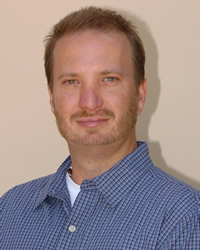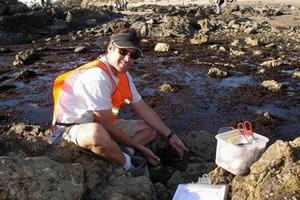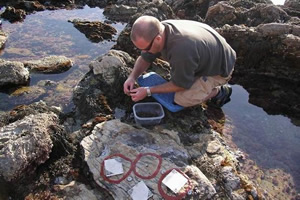Staying Alive
Researchers Find Way to Keep Rockweed in Tide Pools Healthy
May 12, 2009
By Russ L. Hudson
Rockweed is to tide pools what kelp is to deeper waters: food, habitat and protection.
Eliminate rockweed (Silvetia compressa) and the population of small marine animals drops precipitously. Large expanses of rockweed in tidepools from Washington to Ensenada have been trampled to near oblivion by beach goers insensitive to the dangers of habitat destruction.

Jayson Smith
Two Cal State Fullerton researchers may have found a way to reverse that devastation. Jayson Smith, lecturer in biological science, and biology master’s student Stephen Whitaker, working in the Little Corona del Mar area of Newport Beach, have developed an efficient way to restore rockweed to its native habitat.
The solution seems deceptively simple: Go to untrammeled areas where rockweed thrives, saw off pieces of rock with healthy rockweed attached and glue the pieces to the sides of rocks in the damaged tide pool.
But it took three years, multiple approaches and an $85,000 services agreement from the city of Newport Beach in 2006 to get there.
Path to Success
“We tried seeding and monitored the site for well over a year," Smith said. “That didn’t didn’t work well at all.”
Then they tried transplanting healthy plants from a nearby colony by sawing sections off rocks with rockweed attached and fixing the sawed sections to the tops of other rocks in the restoration area.
“Not many specimens survived the foot traffic,” Smith said, “but we had glued some samples to the sides of rocks as well. People can’t walk on the sides, so most of those survived, and now a new colony is establishing itself. That was the breakthrough. It proved trampling was the key problem and it showed how to get around it.
“Altogether, we had six sites scattered across the Little Corona tide pools, where we tested a variety of both small new plants and larger specimens. The larger plantings on the sides of rocks did best, with or without protection.”

Stephen Whitaker replants Silvetia compressa samples.
Smith and Whitaker spent nearly five months studying literature on past research before starting the field work, with frequent guidance from Steve Murray, dean of the College of Natural Sciences and Mathematics, who has specialized in rocky intertidal zones for decades. It was when Whitaker began monitoring the replanting effort that his long-term work began.
“The big problem was timing. I had to monitor first the seedlings, then later the plantings, when the tide was out, and there never seemed to be enough time before it was back in. I had to be there two or three days a month for a year for the seedlings, then again for for the plantings.”
Smith, who has already conducted a number of marine biological studies in the area, credited Murray as a significant influence.
“Steve Murray was involved from the time we first planned the proposal to writing the final report, including letting Steve Whitaker and I bounce ideas off him as we went,” Smith said. “He helped us anticipate problems and plan possible solutions. Listening to him, seeing his thought processes, has made me a more creative teacher.”
Murray, pleased with the project, said, “This project addresses an increasingly important question — how can we improve degraded rocky intertidal habitats? Steve Whitaker and Jayson Smith have been the leaders in carrying out this field-intensive project.”
Results Reported

Jayson Smith preps seedings at the Little Corona del Mar tide pool in Newport Beach.
The two researchers submitted their findings in an April 8 report. A presentation on the restoration efforts — including Smith and Whitaker’s research — will be given by Weston Solutions, Inc., an environmental restoration company hired by Newport Beach to administer many of the city’s environmental projects and conduct others.
Smith and Murray were principals on the project. Whitaker’s previous work as a marine biological consultant before starting his graduate studies earned him significant input on the research design and considerable operational responsibility. Once actual work began, Whitaker and his recruits replanted most of the rockweed.
“What I liked most about the study was two things,” the graduate student added. “First, it’s beautiful out there, some of the most coveted real estate in the United States. The other thing was using all that I’d been taught in classes, including how to carry out a project independently.
“Of course, it’s also a good feeling to know that, in some way, the work can benefit the city and the greater scientific community. I guess that’s three things, isn’t it?” said Whitaker, who defends his master's thesis this month.
Smith earned his doctorate in ecology and evolutionary biology from UCLA, where his research was on factors affecting rocky-shore intertidal zones, with an emphasis on mussel beds. He has been a full-time lecturer and postdoctoral researcher in Cal State Fullerton’s Department of Biological Science since 2005.

